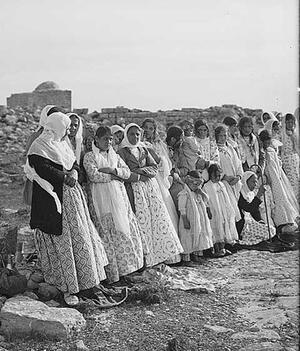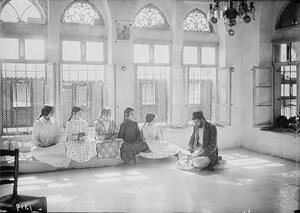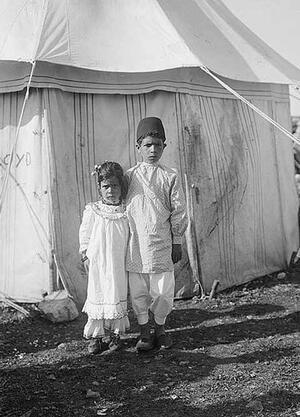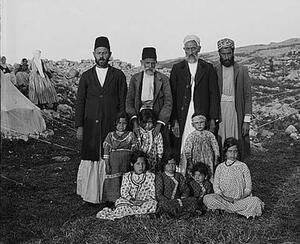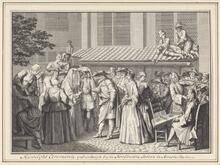Samaritan Sect
While they do not consider themselves Jews, the Samaritans draw their beliefs from the Torah. Samaritan liturgy featured women prominently and showed them in positions of power. However, there is a lack of women in the current Samaritan community, and any Samaritan women are subject to strict laws. Samaritans have extremely strict traditions about letting members marry outside of the community, and conversion to Samaritan ideas is rare and lengthy. Marriage between cousins is common and rules pertaining to divorce and adultery favor the man. Samaritans also have stringent laws surrounding ritual purity, including customs by which some women feel humiliated. Modern Samaritan women have attempted to reform these traditions, but the men do not support these efforts.
Introduction
It is difficult to make general judgements about the status of women in the Samaritan sect as there is little historical information available. That which derives from contemporary Halakhic decisions written by rabbinic authories in response to questions posed to them.responsa[jwa_encyclopedia_glossary] is colored by the status and gender of the respondents and the degree to which they wish to reform the [jwa_encyclopedia_glossary:317]halakhic situation that governs male-female relationships. However, it is important to indicate the origin of Samaritan halakhah as it governs male-female relationships, since this to some extent clarifies the position in which Samaritan women find themselves today.
Descendants of the northern tribes of Israel, the Samaritans may be said to represent the Biblical Israelites. Though they claim that they are not Jews, this claim is doubtful. In Second Temple days they were regarded as halakhically Jewish. In the nineteenth century they were put under Jewish protection by Rabbi Abraham Hayyim Gagin, who described the Samaritans to the Ottoman Turks as a branch of Israelites “who believe in the sanctity of the Torah she-bi-khetav: Lit. "the written Torah." The Bible; the Pentateuch; Tanakh (the Pentateuch, Prophets and Hagiographia)Torah.” This is the minimal view maintained today; most scholars would argue that the Samaritans are a Jewish sect.
The Samaritans’ religious laws are based on the Pentateuch Jewish law of the pre-oral law period and traditionally they were regarded as Jews because of this similarity. Where the Torah has been supplemented or reinterpreted by oral law, the Samaritans may differ in their practice; they may also differ in their interpretation of the Torah text, particularly regarding marriage.
The Samaritans, whether they live in Holon, Israel, or Nablus (Shechem), Palestinian Authority, are bound by the law of the respective authority. However, in all religious matters they are recognized as a religious community. There exists a Samaritan Lit. "house of judgement." Jewish court of lawbet din that deals with matters of marriage and divorce; its religious decisions are delivered by the High Priest, who is involved in all religious ceremonies, including marriage and divorce.
Fearful of influences that will impinge upon their traditions, Samaritans are reluctant to involve themselves with non-Samaritans, but their children attend Israeli state schools, and the males serve in the Israeli army, though the women are exempt from military service.
In History
While there is little information about their status, there are indications that some Samaritan women have held positions in which they may have wielded considerable power. Whether or not they were in fact able to do so is not always clear. It may well be that Samaritan women were used as chattels to cement mésalliances. The first such instance was the unnamed daughter of Sanballat, Pehah of Samaria in Nehemiah’s time (Neh. 13:28), whose marriage to the grandson of the High Priest Joiada must have been an act of anti-Judaean policy. A second such woman was Malthace, one of the ten wives of Herod (AJ xvii.19(3)) whose son, Archelaus, became an Ethnarch, while another son, Herod Antipas, became a Tetrarch after Herod’s death and a daughter, Olympias, in typical Samaritan fashion, married her uncle, Joseph. (See Herodian Dynasty family tree.) The Samaritans seem to have exercised some influence under Herod and Archelaus. Another woman of limited political influence was the unnamed leader of the abortive rebellion of the Samaritans in the reign of Anastasius (491–518); she led the rebels up Mt. Gerizim, where they slew the Roman guards, but was unable to persuade the Samaritans in Nablus to join a general revolt.
Though the matriarchs Sarah, Rebecca, Rachel, and Leah pray a prominent role in Samaritan liturgy, especially in any service where there is a reference to women—such as the burial service for women—female biblical characters are generally famous—or infamous—among the Samaritans in the role of witches or having a malign influence. According to the Asatir, (pitron 1:26), Adam separated himself from Eve for one hundred years because she had supported Cain. Gifna, the daughter of Naamah, sister of Tubal Cain, initiated the pre-Noahide period of divine disfavor, the fanutah. Skilled in witchcraft, she invented the art of music, made idols and taught idolatry to Noah’s contemporaries (Asatir, pitron 3: 20–30).
Among Samaritan folktales preserved in their chronicles are stories of women, all of whom seem to be involved with priestly families. Most of these stories, which are few, have a sexual bias. One such, which follows the witchcraft tradition, is the story of Sul, the maidservant of the High Priest Nathaniel, who had an affair with her master’s son, Bahaam, and then resorted to a magician (Simon Magus) to have him slain. When the matter was exposed, she was put to death.
Another story involves Miriam, the daughter of the High Priest Eleazar, who fled Nablus to avoid being married to the child of her guardian after the death of her father. Since the story seems to fit what is known today of Samaritan marriage rites and practices, it may have some historical basis. The most famous of such stories is that of the unnamed daughter of the High Priest Amram, a close parallel to the Apocryphal story of Susannah, in which a charge of lewdness is laid. The story indicates that a woman could study the Torah and indeed she is said to have written a Torah scroll—an unlikely circumstance in view of the Samaritan attitude to Menstruation; the menstruant woman; ritual status of the menstruant woman.niddah. She is also said to have become a nezirah for a year. The story implies that prostitution was not unknown among Samaritan women, a view apparently borne out by the tale of the Samaritan woman in John 4, though this story may be much misunderstood, the five husbands being the ba’alim of the five nations of 2 Kings 17:24–41.
The Contemporary Situation
The status of Samaritan women today seems to be dominated by four factors: the dearth of women in the community, the desire of the community to avoid diluting its traditions, genetic problems deriving from inbreeding, and the rules pertaining to ritual purity. The strictness of these rules may have remained relatively unchanged through the ages and seem to have been a source of divisiveness between the Jewish and Samaritan communities since Mishnaic times, perhaps because of Samaritan belief in secondary contamination (Codification of basic Jewish Oral Law; edited and arranged by R. Judah ha-Nasi c. 200 C.E.Mishnah Niddah 7:3). A fifth factor is the desire of some Holoni Samaritans to reform the practices related to niddah, which has generated a more assured approach to modernity among Samaritan women. Would-be reformers among the Samaritans consider that it is the Nablus community, which has not come to terms with western modernity, which holds Samaritan women back.
The Dearth of Females
The following statistics help to explain the attitude to the marriage of women among the Samaritan community. In 1969 there were 414 people in Holon and Nablus: 187 females and 227 males. In 1990 there were 544 people, of whom 244 were female and 300 males. Of the latter, 228 were married, 290 were single and twenty-six were divorced or widowed. The manifest shortage of females predicates that the custom of early marriage is maintained, though to a lesser degree than previously: even today a substantial proportion of the females are betrothed while they are in infancy, though women have more rights today than was customary in the past and must give their consent to marriage. Since their wishes are considered, some marry later. The solution to the shortage of females is to import them from elsewhere.
Until recently the Samaritans permitted marriage only when both the man and woman were Samaritan by birth. In the past, the community elders viewed mixed marriages with Jewish women with disfavour and there was a serious controversy in the 1920s when Yafet Tsedaqa, the community head, married a Jewish woman, Miriam Chaikin. Recently several marriages with Jewish women have been permitted, so long as the woman takes on the principles of the Samaritan religion. Marriage to Jewish women is appealing because it opens the gene pool, thereby avoiding genetic problems caused by too close a relationship. Opening of the gene pool is structured to admit no male from outside the Samaritan community.
Samaritans are reluctant to permit marriage to Jewish males since this reduces the available pool of partners and may contaminate their tradition. While the Samaritans have no fixed conversion process, it is obligatory for a Jewish woman entering the community to live with the Samaritans for six months to learn all their rules and customs. During this period, she attends Sabbaths and festivities and learns the way of life, acquiring knowledge on which she is tested. The couple must promise to live within the community, while the male has also to promise to raise his family according to Samaritan ideas.
Genetic Problems
The Samaritans are heavily inbred, with cousin-marriage a frequent phenomenon. The following statistics are relevant to their desire to open the gene-pool by marriage with Jewish women.
Family relationships of married couples in Holon
| Status of relationship | Percent | Number |
|---|---|---|
| Cousin (paternal uncle) | 20.4 | 12 |
| Cousin (maternal uncle) | 12.3 | 7 |
| Cousin (paternal aunt) | 2 | 1 |
| Cousin (maternal aunt) | 2 | 1 |
| From other families | 61.3 | 36 |
A table displaying percentage and numerical statistics for family relationships of married couples in Holon
Statistical research on miscarriages among Samaritan women began in 1933. In 1963 additional research was undertaken in Nablus and after the Six Day War the statistics were correlated with those from Holon. Statistical research suggests that the number of pregnancies in childbearing years is higher than the western average and is similar to the statistics for tribal Africa, where contraceptive devices are not used. The percentage of miscarriages or still-born children is ten percent higher than in the western world and the number of deaths before the age of two is five percent higher. There was no significant difference between the Samaritan communities in Nablus and Holon and there was no correlation between the blood types of the parents and pregnancies without complications or infantile mortality.
The Samaritan halakhah of marriage and divorce is based on the Torah. Brother and sister marriage is forbidden, as is marriage with a niece or nephew. Cousin marriages are permitted and may be said to be the Samaritan norm. The marriage of a priest and a divorcée is forbidden. Marriage to a wife’s sister or to a husband’s brother is forbidden, since Samaritans interpret Leviticus 18:16 as forbidding such marriages and they interpret Deuteronomy 25:5–10 as referring to one born of the same family though not of the same parent. Thus, the theory of Marriage between a widow whose husband died childless (the yevamah) and the brother of the deceased (the yavam or levir).Levirate marriage differs from that pertaining among Rabbinic Jews, though at one stage their rituals may have been identical (Massekhet Kuttim 14). The Samaritans have retained the custom of paying the bride price referred to in the Torah (Exodus 22:16).
While the position of Samaritan women in the matter of divorce is not halakhically clear, it appears to be inferior to that of the male. For example, because of the shortage of women in the community, the priest can declare a betrothal or a marriage void, even against the will of the female partner, if the husband is overseas and incommunicado. In general, the halakhah is weighted in favor of the male.
Divorce is permitted where there is considerable conflict, considerable dislike, or physical defect, and in the case of incurable or mental illness. A wife’s barrenness is not grounds for divorce, but the husband is permitted (in this circumstance alone) to take a second wife without impinging on the rights of the first wife. A third marriage in these circumstances is not permitted and there is no general rule regarding how long one must wait before proving a marriage childless. The minimum is held to be one year, but ultimately the period depends on the High Priest, who may withhold permission.
Divorce used to be rare, but remarriage upon the death of a partner was not infrequent. In the eighteenth-century Mills reported that he was told that the penalty for divorce was death and that he was assured that divorcées had been executed, though not within living memory. Marriages to third wives were known and one man, Salamah B. Jacob, is alleged to have married seven times. All seven wives died.
THE RULES OF NIDDAH
The status of women and the Samaritan attitude to women are most evidently affected by the laws of niddah, the biblical rules of which (including problems of secondary contamination) are strictly observed by women who regard themselves as observant of the laws of the Torah.
When a woman has her regular flow of blood, the impurity of her monthly period will last seven days, and anyone who touches her will be unclean till evening. Anything she lies on during her period will be unclean, and anything she sits on will be unclean. Whoever touches her bed must wash his clothes and bathe with water, and he will be unclean till evening. Whoever touches anything she sits on must wash his clothes and bathe with water, and he will be unclean till evening. Whether it is the bed or anything she was sitting on, when anyone touches it, he will be unclean till evening. If a man lies with her and her monthly flow touches him, he will be unclean for seven days; any bed he lies on will be unclean. (Leviticus 15:19–24)
During her menses a woman is exempt from looking after husband and children. She can do anything she wants other than touch her husband, her children or cooking utensils. She has her own utensils for cooking and eating at this time and these she washes herself. Not only sexual contact but all touching of her husband is forbidden. Women are not allowed to enter a synagogue for fear that they will get their period there and thus render the place ritually unclean. There is no women’s section in the Samaritan synagogue.
During her menstrual cycle a woman is unclean for seven days and pure at the end of the seventh day. After the birth of a male child, she is impure for forty days, with the addition of the day of the circumcision. After the birth of a daughter, she is impure for eighty days. One result of the forty-day period is that the mother acts as sandak for the circumcision of the male child, who is also ritually unclean from contact with the mother. Hence, no one else can perform this task without being defiled.
At the end of the period of niddah the woman purifies herself at home by immersion in a bath of warm water. Before the immersion, she removes the plug, turns on the tap and immerses herself. This is a symbol of living water. She must also wash all the clothes that she has worn during menstruation and rinse everything that she has used or touched, after wrapping the items in plastic. Eating utensils must be washed in running water. Items which cannot be washed are burned. The niddah takes a piece of torn paper, lights it and passes it over the bed (on the basis of Numbers 31:23).
Niddah is regarded as a matter of public concern. Women are supposed to give unmistakable signs of their situation. In the past it was the custom to carry a chair from place to place as an indicator of the situation, to avoid errors in contaminating others. At the time of her niddah the woman is separated even from her core family. She may have physical contact with neither her children nor her husband. She is forbidden to touch the household goods or render any services to the household. For this, another woman from the extended family comes into the house for a fixed period.
Though some women resent niddah being considered a humiliation and say that they take it as part of life, many others dislike the practice, finding the various details of fulfilling this custom degrading and humiliating. For example, food and drink are not handed to them, but put in a special bowl on the floor. At every social event the niddah women sit together in a special corner and they take no active part. The state of niddah is particularly bothersome at festive times, when all the community gathers on Mt. Gerizim. If a woman is niddah during A seven-day festival to commemorate the Exodus from Egypt (eight days outside Israel) beginning on the 15th day of the Hebrew month of Nissan. Also called the "Festival of Mazzot"; the "Festival of Spring"; Pesah.Passover she cannot eat of the sacrifice. (In any event women take no part in rituals except minimally on The Day of Atonement, which falls on the 10th day of the Hebrew month of Tishrei and is devoted to prayer and fasting.Yom Kippur).
REFORMS SOUGHT
Because they suffer from social isolation and the inability to take part in household affairs, women use various devices to ameliorate their situation. They have started to use contraceptive devices for lengthy periods, especially at festive times or when there are social occasions. Because the laws of niddah are Torah-based they are observed rigorously and have not changed with the transfer from Nablus to Holon.
However, the younger generation has been pressing the priesthood and the elders of the community to lighten the more burdensome aspects of the customs. For example, there is a desire to shorten the period of niddah after birth. Some want to build a special building where all the niddah women can live, so that it is easier for them to carry out the rules when together. Those against reform point out that change already takes place, reflecting contemporary changes in attitude. Thus, it is no longer forbidden to touch even the shadow of a menstruating woman.
In general, Samaritan males are not in favor of reform, arguing that the period of ritual uncleanness is for the good of the family and that a husband who must put himself in his wife’s place for seven days each month becomes more understanding of her position. Samaritan males justify their attitude by arguing that a woman’s position is more comfortable among the Samaritans as she has only one obligation—not to disobey her husband—whereas the male has more obligations to his wife.
Aleph-Beth Samaritan News 16 (1990), 511–512.
Bin Gorion, M. J. B. Mimekor Yisrael: Classical
Jewish Folk Tales, Vol.1. Bloomington and London: 1976, 311–319.
Reproduces legends of the Samaritans from various chronicles and other sources.
Bóid, I. R. M. Principles
of Samaritan Halachah. Leiden: 1980.
Has a detailed study of the different kinds of niddah and presents various
Samaritan halakhic texts and compares them. Bóid also compares the Rabbinic
and Karaite sources on the same matters.
Bowman, John. Samaritan
Documents Relating to Their History, Religion and Life. Pittsburgh:
1977.
Presents translations of the text known as the hillukh and offers a commentary
on some Samaritan practices relating to marriage.
Mills, J. Nablus and the Modern Samaritans. London: 1864.
Montgomery, J. A. The
Samaritans. New York: 1968.
Has a convenient text of the Massekhet Kuttim, but his commentary is somewhat
scant.
Prest, L.A. “The Samaritan Woman.” The Bible Today 30 (1992), 367–371.
Pummer, R. Samaritan
Marriage Contracts and Deeds of Divorce. Wiesbaden: 1993–1997.
The best selection of material on Samaritan marital and divorce practices
with a careful eye for the factors concerned in relating to modern times.
Rogers, M. E. Domestic
Life in Palestine, Second Edition. London: 1989.
A very good account of her experiences with Samaritan women in the nineteenth
century.
Stenhouse, Paul. The Kitab al-Tarikh of Abu’l Fath. Sydney: 1985.
Tsedaqa, Ratson, and Dov Noy. Samaritan Legends. Haifa: 1965.
Zevit, Ziony. “The Gerizim-Samaritan Community in and between Texts and Times: An Experimental Study.” In The Quest for Context and Meaning, edited by C. A. Evans and Shemaryahu Talmon, 547–572. Leiden: 1997.

